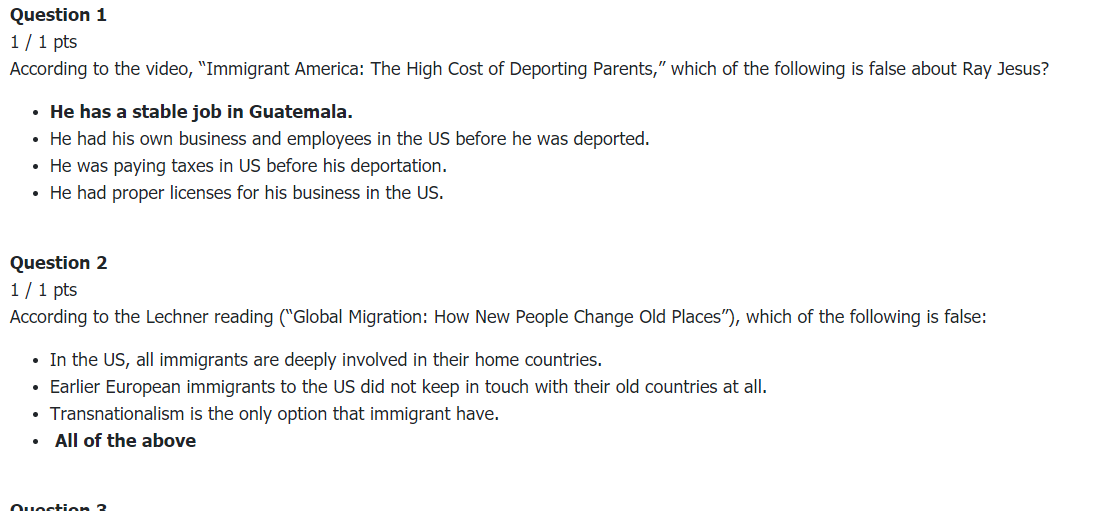(Solved): ASB 378 Module 2 Quiz : Score for this quiz: 17 out of 17 : Attempt 1 ...
Score for this quiz: 17 out of 17
Submitted Mar 26 at 7:16 am
This attempt took 47 minutes.
Question 1
1 / 1 pts
According to the video, “Immigrant America: The High Cost of Deporting Parents,” which of the following is false about Ray Jesus?
- He has a stable job in Guatemala.
- He had his own business and employees in the US before he was deported.
- He was paying taxes in US before his deportation.
- He had proper licenses for his business in the US.
Question 2
1 / 1 pts
According to the Lechner reading (“Global Migration: How New People Change Old Places”), which of the following is false:
- In the US, all immigrants are deeply involved in their home countries.
- Earlier European immigrants to the US did not keep in touch with their old countries at all.
- Transnationalism is the only option that immigrant have.
- All of the above
Question 3
1 / 1 pts
According to the second lecture of this module (“Local Host Society Responses to Immigration”), host societies generally want skilled immigrants, but not unskilled ones
- True
- False
Question 4
1 / 1 pts
According to the video, “Immigrant America: The High Cost of Deporting Parents,” Ray Jesus, the deportee from the US, has a wife and children in Utah.
- True
- False
Question 5
1 / 1 pts
According to the first lecture of this module (“Overview, Causes, and Impacts of Global Migration”), the total volume of internal migration is considerably smaller than the number of international migrants.
- True
- False
Question 6
1 / 1 pts
According to the first lecture of this module (“Overview, Causes, and Impacts of Global Migration”), the total number of global migrants is still only 10 percent of the world’s population of 6.8 billion.
- True
- False
Question 7
1 / 1 pts
According to the third lecture of this module (“Transnational and Diasporic Migrant Communities”), which of the following are created by the migratory dispersal of one ethnic group to various countries around the globe because of ethnic and political persecution, but also because of economic or other reasons?
- Refugees
- Asylum seekers
- Diasporas
- Economic migrants
Question 8
1 / 1 pts
According to the Tsuda reading (“Unequal in the Court of Public Opinion”), the number of Mexican immigrants reached 29 percent of the total immigrant population in the US. in 2010
- True
- False
Question 9
1 / 1 pts
According to Cornelius and Tsuda reading (“Controlling Immigration: The Limits of Government Intervention”), in Western Europe, regional trade liberalization, combined with large flows of development aid from richer to poorer EU member countries, halved wage disparities and transformed labor exporters like Italy and Spain into labor importers.
- True
- False
Question 10
1 / 1 pts
According to the first lecture of this module (“Overview, Causes, and Impacts of Global Migration”), which of the following is false about high-skilled and professional immigrants?
- They are all white people who come from Europe and Canada.
- They tend to come from middle class or elite backgrounds and are highly educated
- Many are originating from less developed countries from the Global South such as China, India, and the Philippines.
- They are seeking better professional and educational opportunities abroad.
Question 11
1 / 1 pts
According to the Tsuda reading (“Unequal in the Court of Public Opinion,” assigned for the Public Opinion class), one reason Americans dislike Mexican immigrants but don’t mind Asian immigrants is because statistics show that there are significantly fewer Asian immigrants compared to Mexicans
- True
- False
Question 12
1 / 1 pts
According to the second lecture of this module (“Local Host Society Responses to Immigration”), there is no noticeable connection between negative public opinion toward global migrants and immigration control policies.
- True
- False
Question 13
1 / 1 pts
According to the Lechner reading (“Global Migration: How New People Change Old Places”), after the oil boom of the early 1970s, newly rich states in the Middle East attracted workers from India and the Philippines.
- True
- False
Question 14
1 / 1 pts
According to the first lecture of this module (“Overview, Causes, and Impacts of Global Migration”), the number of people living outside their country of birth increased 155 percent from 95.5 million in 1970 to 258 million in 2017
- True
- False
Question 15
1 / 1 pts
According to the video, “Walls of Shame: The US-Mexican Border,” what happens to the distressed undocumented Mexican migrant that the Samaritan volunteer encounters in the desert?
- He returns to Mexico
- He continues walking through the desert into the US despite his miserable condition
- The Samaritan turns him over to the US Border Patrol
- He gets in the car with the Samaritan so she can drive him to safety
Question 16
1 / 1 pts
According to the Tsuda reading (“Unequal in the Court of Public Opinion,” assigned for the Public Opinion class), Asians are more assimilated than Mexicans because they are more willing to become assimilated whereas Mexicans do not want to assimilate
- True
- False
Question 17
1 / 1 pts
According to the Tsuda reading (“Unequal in the Court of Public Opinion”), which group is often stereotyped by the public as an unassimilated immigrant group that is unwilling or unable to give up its foreign culture and language and become part of the national community in US?
- Chinese
- Mexicans
- Iranians
- Vietnamese
Expert Answer

Buy This Answer $15
-- OR --
Subscribe $20 / Month
